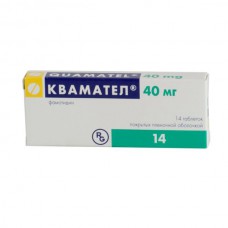Expiration date: 06/2026
The composition and form of issue:
Tablets, film-coated. 1 tablet contains:
famotidine 20 or 40 mg
excipients the core of tablet: silica colloidal, anhydrous magnesium stearate povidone K 90 sodium carboximetilkrahmal, such As talc maize starch lactose monohydrate
the composition of the shell: red iron oxide Color. 77491 ind. colloidal silica, anhydrous titanium dioxide macrogol 6000 sepifilm 003 (5,9517 mg hypromellose + 0,6613 macrogol mg stearate)
blistere in 14 PCs. in cardboard box with 2 blisters (table. 20 mg), or blistere in 14 PCs. in cardboard box 1 blister (tab. 40 mg).
Powder lyophilized for solution preparation for injections. 1 vial contains:
famotidine 20 mg
auxiliary substances: aspartic acid mannitol
solvent: sodium chloride water for injections
in vials together with the solvent in vials, a knife ampulnam in a box of 5 sets.
Description pharmaceutical form:
Tablets 20 mg: pink convex coated tablets, marked "F20" on one side.
Tablets 40 mg: dark pink, convex tablets , marked "F40" on one side.
Pharmacokinetics:
Once inside C max achieved within 1-3 h and is 0.07–0.1 mg/ml. Bioavailability of 40-45%. T1/2 from plasma is 2.3–3.5 hours, with Cl creatinine less than 10 ml/min T1/2 may increase to 20 h Passes through the placenta and is excreted in breast milk. After receiving the drug inside, in an unmodified form with urine output 30-35%, and after in/introductions — 65-70% of the drug.
Description pharmacological action:
Selectively blocks histamine H2-receptors. Decreases basal and stimulirovannuyu secretion of gastric juice, the content of hydrochloric acid and pepsin. The action starts in 1 hour and lasts for 10-12 h After in/introductions the maximum effect develops within 30 minutes does Not affect the enzymatic system of cytochrome P450 in the liver and metabolic rate at the same time accept drugs that biotransformiroyutza with the participation of cytochrome P450.
Indications:
For admission into:
- peptic ulcer disease duodenum and stomach in the acute phase, prevention of recurrence
- treatment and prevention of symptomatic ulcers of stomach and duodenum (associated with taking NSAIDs, stress, postoperative)
- erosive gastroduodenitis.
- functional dyspepsia associated with increased gastric secretion
- reflux esophagitis
- syndrome zollingerellison
- prevention of recurrent bleeding from upper gastrointestinal tract
- prevention of gastric aspiration under General anaesthesia (Mendelson's syndrome).
For the on/in the introduction:
- peptic ulcer disease duodenum and stomach in the acute phase
- symptomatic ulcers and their prevention
- reflux esophagitis
- syndrome zollingerellison
- prevention of gastric aspiration under General anaesthesia (Mendelson's syndrome)
- bleeding from the upper gastrointestinal tract (in the complex treatment).
Contraindications:
- hypersensitivity to famotidine and other histamine H2-receptors
- pregnancy
- breast-feeding
- the children's age.
Side effects:
Dry mouth, nausea, vomiting, flatulence, constipation, diarrhea, loss of appetite, increased liver enzymes, headache, dizziness, tinnitus, fatigue, drowsiness, transient mental disorders, fever, arrhythmia, muscle pain, joint pain, alopecia, ordinary acne, dry skin, itching, bronchospasm, and other symptoms of hypersensibility. Very rarely — agranulocytosis, pancytopenia, leukopenia, thrombocytopenia.
Drug interactions:
By increasing the pH of gastric contents while admission may decrease the absorption of ketoconazole. In the case of Kvamatel with antacids, the break between their admission must be at least 1-2 hours
Method of application and dose:
Inside. When ulcers stomach and duodenal ulcer in acute phase: 40 mg 1 time a day at bedtime or 20 mg 2 times a day. If necessary, the daily dose may be increased to 80-160 mg. of the Course of treatment 4-8 weeks. To prevent relapse: 20 mg 1 time per day before sleep. When reflux esophagitis: 20-40 mg 2 times a day for 6-12 weeks. The syndrome of zollingerellison: dose and duration of treatment is determined individually, the starting dose is usually 20 mg every 6 hours During General anesthesia to prevent aspiration of gastric juice: inside of 40 mg the evening before surgery and/or morning before surgery.
In/in struino or drip (used when it is impossible ingestion). Usual dose — 20 mg 2 times a day (every 12 hours).
Zollingerellison syndrome: initial dose is 20 mg every 6 h. further the dose depends on the level of acid secretion and the clinical condition of the patient.
To prevent complications of acid aspiration possible enter/20 mg before surgery or at least 2 h before the operation.
Single dose at/in the introduction should not exceed 20 mg.
In renal failure, if creatinine Cl is <30 ml/min or serum creatinine blood &ge3 mg/100 ml, the daily dose should be reduced to 20 mg or increase interval between doses to 36-48 h
Daily dose of Quamatel at/in the introduction is 20 mg every 12 hours
For/in the introduction of the jet content of the vial is dissolved in 5-10 ml of 0.9% sodium chloride solution (ampoules with solvent, supplied), are introduced slowly (within 2 min).
For in/drip in the introduction of the contents of a bottle dissolve in 100 ml of 5% glucose solution for infusion and administered within 15-30 min.
The prepared solution can be stored at room temperature for 24 h.
Overdose:
Symptoms: vomiting, motor agitation, tremor, decreased blood pressure, tachycardia, collapse.
Treatment: gastric lavage, symptomatic and supportive treatment, hemodialysis.
Precautions:
Before the start of therapy with blockers of H2-histamine receptors is necessary to conduct a histological examination of biopsy material from the region of the ulcer in order to exclude a malignant nature of the disease. Should be used with caution and in reduced doses to prescribe the drug to patients with impaired liver function.




